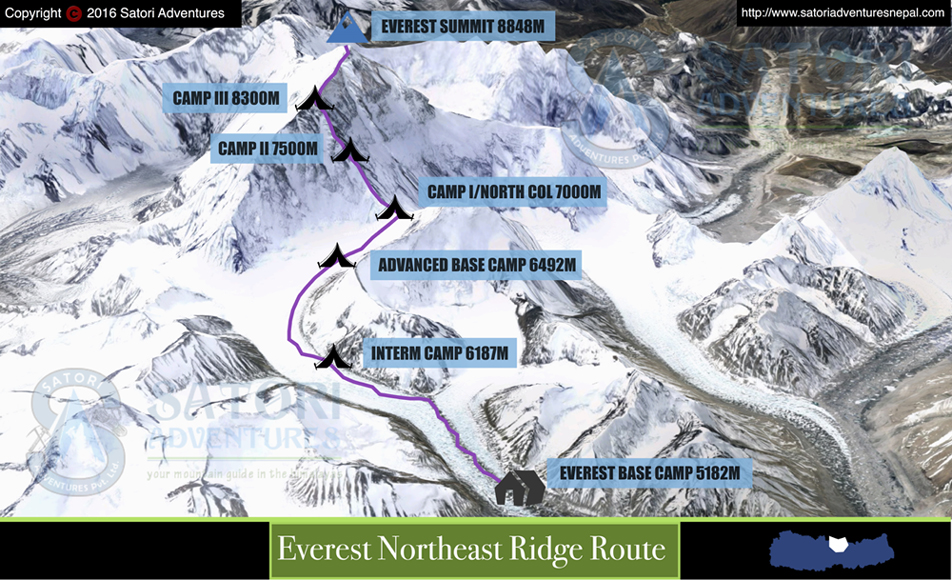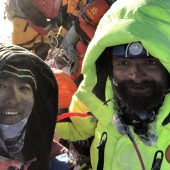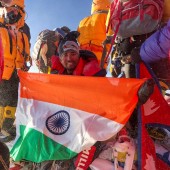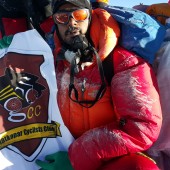Everest Expedition from Tibet north face side pursued north route is a famous mountain expedition in the world. The Everest North is a relatively more straightforward route than Mt. Everest's south face climbing. Mt. Everest is the tallest mountain globally (29,029 feet/8,848 meters), an incredible challenge and experience. Satori Adventures offers a full-service expedition of this world-renowned peak with an average number of climbers and a 1:1 climbing Sherpa/guide to each climber. We are committed to providing the highest support level with reliable and experienced climbing guides, Sherpa support, and the best high-end gear.
The first attempt at Everest from the north side was by a British team in 1921. George Mallory led a small group to be the first human to set foot on the mountain's flanks by climbing up to the North Col 7,003 meters (22,975 feet). The second expedition, in 1922, reached 8,321 meters (27,300 feet) before turning back—the first team to use supplemental oxygen. The 1924 British tour with George Mallory and Andrew "Sandy" Irvine is most notable for the mystery of whether they summited. If they did summit, that would precede Tenzing and Hilary by 29 years. Mallory's body founded in 1999 along the north side route, but there was no proof that he died going up or coming down. A Chinese team made the first summit from Tibet on May 25, 1960. Nawang Gombu (Tibetan) and Chinese Chu Yin-Hau and Wang Fu-Zhou, who is said to have climbed the Second Step in his sock feet, claimed the honor. In 1975, on a successful summit expedition, the Chinese installed the ladder on the Second Step. Tibet was closed to foreigners from 1950 to 1980, preventing further attempts until a Japanese team summited in 1980 via the Hornbein Couloir on the North Face. There have been 4,428 total summits of Mt. Everest up to 2014.
Satori Adventures always offers an incomparable competency, safety, and comfort in the Everest north (Tibet side) expeditions. In mountaineering, small group size still allows us to adapt to changing conditions and weather far more quickly than many commercial teams, which have become so large over the last five years that they have become difficult to manage. As per our previous experience, there are only 2-3 summit windows allow by nature because of weather conditions. Satori Adventure always supplies and provides fresh and nutritious food at base camp and provides request types of hygienic food above base camp. We always give good Masks, regulator, and Oxygen bottle that adds up to a far more enjoyable experience and successful climb. We follow the itinerary is made possible by utilizing per-acclimatization in hypoxic tents. For Everest Expedition, our company's climbing Guides are highly skilled, time to time reviewed and recognized worldwide due to their training and experiences in this profession and paid up the high range of wages and fees. To these guides and climbers in our Everest Expedition, we will put on a rope. A challenging climb with severe consequences should things go wrong. One of the most things we have to keep in mind while operating the Mt. Everest Expedition is prevention. Everest's north side begins at the Chinese Base Camp (5,150 meters located at the Rongbuk Glacier. The Chinese Base Camp is accessible from Tingri by jeep.
We offer a very competitive cost for climbing Everest from the north face. Our professional service is highly affordable, ensuring the summit's maximum success rate is our primary motto. You will found safety with a highly-skilled mountain base camp and climbing service from Kathmandu to Tibet.
Located on a gravel area 8 kilometers above Rongbuk Monastery, this is the end of the road. All vehicle assisted evacuations to start here, and there are no helicopter evacuations possible in Tibet. Everest Base Camp is a term used to describe two base camps on opposite sides of Mount Everest. The North Base Camp is in Tibet at 5,150 meters (16,900 ft) latitude of 28°8′29″N and longitude of 86°51′5″E. These camps are rudimentary campsites that are used by mountain climbers during their ascent and descent. Climbers typically rest at base camp for several days for acclimatization to reduce altitude sickness risks and severity.
The intermediate camp is used on the first trek to ABC during the acclimatization process. You will also have no more than a resting place for the night where a few tents fix. This area can be lightly snow-covered or with no snow at all, depending on the weather. Most climbers only stop here, ascending to advance camp from base camp. When descending, you can walk from ABC to BC in about 6 hours, and this camp will not be necessary.
Advanced Base Camp on the north side of Everest is one of the world's highest advanced base camps. This position makes it shorter and more comfortable for climbers to reach base I, II, and III from advanced base camp. Most teams will use ABC as their primary camp during the acclimatization period, but some climbers may need to descend to the intermediate camp to acclimate due to its altitude. ABC may or may not be snow-covered and offers stunning views of the North Col.
Camp I is located just above the East Rongbuk Glacier. Most climbers will use crampons upon reaching the glacier. Within an hour of starting the ascent on the glacier, climbers will begin to utilize a fixed-line and cross ladders placed over deep crevasses. In some areas, the use of an ascender on the fixed rope will be beneficial. Rappelling or arm-wrapping techniques are uses to descend the steeper areas of this section. Generally, climbers will spend 4-5 nights at camp- I during the expedition.
The route to Camp II consists of a steep and snowy ridge that eventually turns to rock. High winds are sometimes a problem during this section, making it especially cold. The wind and air pressure are usually higher on the north face side versus the south side. Some expeditions use Camp II as their highest camp for acclimatization purposes before beginning the summit push.
Camp III lies along the steep area of the mountain that runs from 8,250-8,350 meters. A few small sites to set up camp III and different expeditions will select other regions of the same general area. This area is steep, rocky, and exposed, and tents are perched on rock ledges and generally battered by the wind. Camp III on the north side is 350 meters higher than the South Col and much more exposed. Most teams use this high camp as the last rest spot before the summit bid.
From camp III to the summit is a long and hard day. Climbers use a fixed rope through the snow-filled gully, which is part of the Yellow Band. From the Yellow Band, the climbers change their oxygen cylinder and take a small ramp up to the northeast ridge. The route veers to the high point's right, and most climbers rate it as steep and challenging. From the Mushroom Rock, located at 8,600 meters, the route can be full of loose rock, adding to the difficulty. The next part of the climb is the Second Step, the climb's crux, as climbers use the Chinese ladder. Climbers first ascend a 10-foot rock slab and then climb the near-vertical 30-foot ladder. This section is very exposed with a 9,000-foot vertical drop. It is generally more challenging to navigate on the decent since you cannot see your foot placement on the ladder rungs. Strong climbers take 9 to 10 hours to reach the summit and return to camp III, while more moderate and less experienced climbers take 11-13 hours. Most climbers use 3-4 bottles of oxygen during the summit push and other bottles between camp II and III.
Highest access: 8,848M/29,029ft.
First Ascent: May 29, 1953 Edmund Hillary & Tenzing Norgey Sherpa
Duration: 59 Days
Group Size: 02-10 People per group
Co-ordinates: 27°59'17'' N / 86°55'31'' E
Location: Nepal/Tibet border, 30km west of Everest
Country: Tibet, China
Airport: Kathmandu airport
Departure From: Kathmandu (KTM)
Grade: Challenging
Accommodation: five star hotel Yak and Yeti
Meals: B/B plan in Kathmandu & B, I, D during trekking and climbing
Transportation: Car, Jeep, Mini Bus
Best season: Spring season(April/May)
Major Activity: Climbing
Include Activity: Sights tour of Kathmandu, Nylam and Tingri
Culture: Tibeten and Sherpa
Mode of Travel: Long along the trail/Camping
Climbing route: Northeast Ridge
Himalayan sights: Lhotse, Makalu, Ama Dablam, Cho-Oyu
Day 01: Arrival in Kathmandu Airport and transfer to hotel, hotel accommodation in Kathmandu (1350M/4430ft).
Day 2-5: Preparation & Visa Process duration at Kathmandu. Hotel accommodation.
Day 06:Drive from Kathmandu to Timure (1832m/6009t, 06-07, hrs.) Hotel accommodation
Day 07: Drive from Kathmnadu to Timure after completing the Immigration formalities drive to Kerung Height (3200m/10499ft, 01 hr.) Hotel accommodation.
Day 08: Drive from Kerung height to Tingri (4,348m/14,268ft, 04-05hr) Hotel accommodation.
Day 09: Rest day at Tingri for acclimatization. The climbing Sirdar will take you up to a (5000m/16404ft) hill for acclimatization after breakfast.
Day 10: Drive from Tingri to the Chinese base camp (4800m/15750ft, 03hrs) Hotel accommodation.
Day 11-12: Rest and acclimatization at Chinese base camp (4800m/15750ft). To arrange yaks to go to advanced base camp via middle camp.
Day 13: Clean the camp trek to Middle Camp and drive to Tingri (4,348m/14,268ft, 04-05hr). Hotel accommodation.
Day 14:Trek from Middle Camp to the ABC (5700m/18700ft) of Everest North camping accommodation.
Day 15-56: Climbing Period (summit Period of Mt. Everest 8848.86m/29032ft.) Camping accommodation.
Day 57: Trek to Chinese base camp (5200m/17060ft.) Hotel accommodation.
Day 58:Drive from Chinese Base Camp Then Drive to Tingri (4,348m/14,268ft, 04 hrs.).
Day 59: Drive from Tingri to Kerung Height (3200m/10499ft, 04-05hrs) Hotel accommodation.
Day 60: After Completing Immigration formalities drive to Kerung to Kathmandu (1350m/4429ft, 08 hrs.) Hotel accommodation.
Day 62: Transfer to the airport for final departure.
For full board clients we provide a personal tent and food, which will be prepared by their climbing Sherpa. We provide UHF/VHF hand held radios on the mountain to maintain communications between ABC and high camps.
We provide a personal climbing Sherpa guide to help the clients reach the summit. The secret of success on Everest is a strong and experienced climbing Sherpa. No matter how good and experienced the climber, it is a long slog. Personal climbing Sherpas will set up camp 1, camp 2 and camp 3. They will also carry food provisions, fuel and oxygen and will guide and assist the client on the summit day.
Satori Adventures provides very professional, helpful and friendly service from Kathmandu to the ABC as well as during the climb. Our objective is to provide a good quality, helpful, safe, friendly, stress free and comprehensive service to maximize summit opportunity.
In the Base camp our cooks and helpers will prepare and serve three delicious freshly cooked and plentiful meals a day and will ensure that hot and cold drinks are available 24 hrs a day. In the Base Camp we provide spacious expedition quality personal tents for all our clients both with full board or base-camp service only.In base camp we also provide dining tent, kitchen tent, toilet facilities and portable shower facilities and tent accommodation for our staff.
In base camp we provide access to communication including satellite telephone and internet access, solar panels to charge your batteries and UHF/VHF hand held radios on the mountain to maintain communications between ABC and high camps.
Our camp manager as well as guides and climbing Sherpa’s have an extensive experience on multiple Everest climbs. They will ensure cooperation with other companies and Base Camp organization. In base camp our guides will work with other teams to ensure contribution from all operators for tasks such as route fixing and to ensure the safety of climbers from ABC to the summit.
Satori Adventures has not able to include the cost of each package in the company website. Many of our clients have the same query: why Satori Adventures has not included the price in the package. To provide you service in reasonable cost and attempt to address your each requirement we desired to provide you with some information which directly affects the cost and also helps us breakdown the cost. That’s why, we have decided to clarify our customers that due to following reasons we have not included the cost in our website and package:
Due to the above position the price range for the same trip can vary widely. So, we would like to discuss with our client before offering the cost. Please feel free to contact Satori Adventures for any information about in your selected package.
It is important for each climber to choose the right expedition guide service that not only suites their needs, but provides the best safely and secure mountaineering experience possible. There are more than 1,700 trekking companies in Nepal who offer 8,000 meter expeditions including Everest, but only about 30 companies who operate 8,000 meter peaks on a regular basis.We are proud to be one of these 30 companies and consistently offer, run and succeed at these types of expeditions year after year.
It is very important that the climbers who choose Satori Adventures for this trip of a lifetime experience have expectations that are compatible with the program we offer and the style of expedition Satori Adventures runs. We do not want to simply “fill our expedition”, but instead we want to comprise a team of companionable people who are focused on reaching the summit with the highest level of support and safety standards that can be provided by a guiding service on Mt Everest. We team this with the best standards of food and quality equipment to further assist each client reach their full potential. We feel that we offer the best environment and opportunity for you to be successful on the world’s highest mountain.
We are always striving to develop and grow our operational systems to ensure you get the best possible experience. Our expedition members do not deserve anything less than the best possible conditions and opportunity to be successful. We do this by limiting our team size, which makes us more flexible as a team and helps ensure the team has the best weather windows for a summit push. We also try to develop an atmosphere where members feel that they are climbing as a family with each guide Sherpa and team member working together and striving for a common goal.We generally accept a maximum of 8 climbers in a group and if we get more than 8, we will spit the team into two or more groups.
The Satori Adventures methodology and tactical approach to climbing Mt. Everest has seen us achieve the highest success rates. Our extensive experience gives us the edge when it comes to making tactical decisions.We provide a consistently higher Sherpa and Guide ratio than any other operator, resulting in more support and backup for your summit attempt, which provides a greater safety margin and chance of success. We always provide a 1:1 ratio of client to Sherpa/guide.
Many of our guides are professionally trained and assessed from the Nepal Mountaineering Association, the International Federation of Mountain Guides Associations (IFMGA), American Mountain Guides Association or other professional training association. This results in our guides have a greater repertoire of skills that enables them to provide a dedicated level of security to you during the expedition. Most of our guides also have been guiding in the Himalaya range for many years and have numerous 8,000 meter summits to their credit and at-least 3 years’ experience guiding on Mt. Everest
Satori Adventures provides the best possible camp facilities, food and service. Our expedition cooks are regarded as the best in the business, provide healthy and appetizing meals with an array of menus to suit all your nutrition requirements. Our cooks provide meals that are designed to sustain your body for the rigouts of the ascent. We also provide diverse choices to suite Vegetarian, Vegan, Indian, or any specified requests.; If you do have a special nutritional request, please let us know 60 days prior to the start of your expedition so we can plan accordingly.
The approach on its Everest North face ridge Base camp is through the Kodari Boarder of Nepal leading up to Rongbuk Glassier. It starts with the drive from Kathmandu to Kodari Border After immigration formalities, drive to Naylam(3700M), to Tingri (4,300m) to Chinese Base Camp (5,150m). It takes typically 10days to reach ABC from Kathmandu.


The Great Trigonometric Survey of India, part of the British Survey of India which began in 1803, made distance measurements of many high Himalayan peaks in the 1850s including those in the Mount Everest region. The Survey established the first published height of Everest, then known as Peak XV, at 29,002 ft (8,840 m). In 1865, Everest was given its official English name.
The northern approach to the mountain was explored by George Mallory on the first expedition in 1921. With Mallory leading (and thus becoming the first European to set foot on Everest's flanks) they climbed the North Col (7,007m). The British returned for a 1922 expedition. George Finch climbed using oxygen for the first time. He ascended at a remarkable speed of 290m/hour, and reached an altitude of 8,320m, the first time a human climbed higher than 8,000m. On 8 June 1924 George Mallory and Andrew Irvine made an attempt on the summit via the North Col/North Ridge/Northeast Ridge route from which they never returned.The Swiss expedition of 1952, led by Edouard Wyss-Dunant, was granted permission to attempt a climb from Nepal. The expedition established a route through the Khumbu ice fall and ascended to the South Col at an elevation of 7,986m.
In 1953, a ninth British expedition, led by John Hunt, returned to Nepal. The first pair (Tom Bourdillon and Charles Evans) came within 100 m (300 feet) of the summit on 26 May 1953, but turned back after becoming exhausted. Two days later, the expedition made its second and final assault on the summit with the New Zealander Edmund Hillary and Tenzing Norgay, a Nepali sherpa climber. They reached the summit at 11:30 a.m. local time on 29 May 1953 via the South Col Route.
On 8 May 1978, Reinhold Messner (Italy) and Peter Habeler (Austria) made the first ascent without supplemental oxygen, using the southeast ridge route. On 20 August 1980, Messner reached the summit of the mountain solo for the first time, without supplementary oxygen or support, on the more difficult Northwest route via the North Col to the North Face and the Great Couloir. He climbed for three days entirely alone from his base camp at 6,500 metres
In 1980, a team from Poland led by Andrzej Zawada, Leszek Cichy, and Krzysztof Wielicki became the first to reach the summit during the winter season.
On 14 May 2005, pilot Didier Delsalle of France landed a Eurocopter AS 350 B3 helicopter on the summit of Mount Everest (without any witness) and took off after about four minutes. (His rotors were continually engaged, constituting a "hover landing", and avoiding the risks of relying on the snow to support the aircraft.) He thereby set rotorcraft world records, for highest of both landing (de facto) and take-off (formally). Delsalle had also performed, two days earlier, a take-off from the South Col; some press reports suggested that the report of the summit landing was a misunderstanding of a South Col landing.

A successful Everest expedition needs everything from an experienced and a strong Sherpa team, cooks, and other staff at the base camp, reliable and well tested equipment such as tents, ropes, high altitude stoves, wide variety of food selection inclusive of fresh vegetables, and fresh fruits, specialized high altitude food, good base camp facilities such as individual tents, clean and well maintained kitchen, dining, shower, and loo tents for the entire team and staff, brand new oxygen bottles, high quality summit masks and regulators for the climbers and Sherpa guides, a comfortable and luxury trek in and out of the base camp, and above all a strong ground operation in Kathmandu that takes care of all government formalities and paperwork, and is available to organize rescues incase of emergencies on the mountain.
Rishi and Satori adventures provided every single thing from the above list, and they went above and beyond all expectations. 6 out of 7 members made it to the top of Mt. Everest and made it back down alive. A big part of this success is due to the Satori adventures' team and organization both on and off the mountain. Rishi as the CEO of Satori adventures provided us full support throughout our Everest climb. Rishi understands how to run a big mountain expedition and deeply cares for the success and safety of all expedition members. Two of the climbers on my team required immediate helicopter evacuation from Camp two, and Rishi organized that without any delay.
If you are looking to climb Everest or any of the other 8000 meter mountains in Nepal or Tibet, I would highly recommend that you go with Satori adventures. And if you are looking to do any trekking or climbing a 6000 meter or a 7000 meter mountain I would again recommend to climb with Rishi and his team. I have now been on three 8000 meter mountain expeditions and one 6000 meter mountain expedition with Rishi and his team and I have no complaints at all. Every single aspect of the expedition is very well taken care of. Highly Highly Highly recommended!

I was a part of Mount Everest North Side expedition of 2019.I could not have asked for better services than provided by Satori and team. Two of our Sherpa s, Mingma Tenzi and Funaru Dai stuck by us like shadows. I owe my safety and success to Satori team. Looking forward to doing more expeditions with them.

Satori adventure Nepal, provides all facilities during our Everest north expedition 2018, services of all staff and of Sherpa was excellent, The owner of the Satori Adventures Mr. Rishi Bhandari made all arrangements perfectly, thanks to Rishi sir and to his team for making and supporting me, my dream of Everest was fulfilled with satori adventure. I am able to summit with safe and successful way because of Satori experience. this company is really profession company. Dreaming of climbing 8,000 meters is not so easy in itself! When you are looking to climb the world s highest mountain, choosing a professional company and an experienced climber Sherpa guide is the main challenge. If you book with Satori Adventure, all you have to do is leave the company and start your training. I wish Satori and entire team all the best for your hard work. Jitesh Modi India
Satori Adventures Pvt. Ltd.
P. O. Box-21378, Naya Bazaar, Kathmandu, Nepal
Phone: +977-1-4965127
+977-1-4951250
Email: info@satoriadventuresnepal.com
Fax: +977-1-4965127
Mob: +977-9851031006
www.satoriadventuresnepal.com